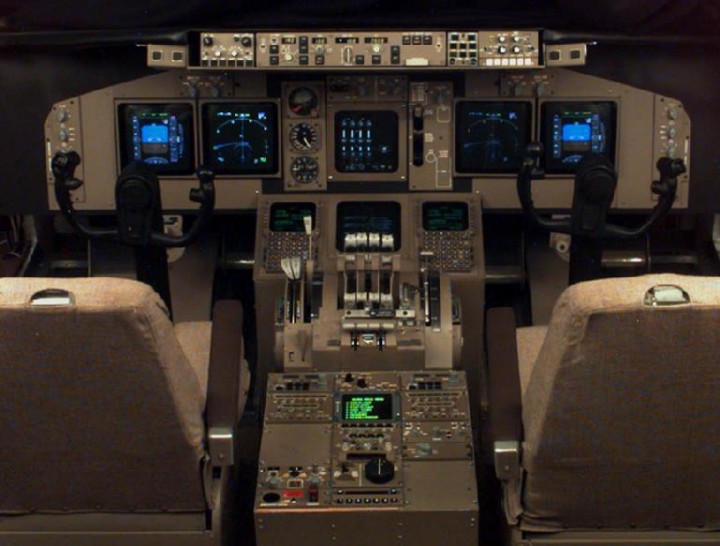Boeing 747 Engineering Cockpit Simulator
Flight Deck Simulation Facilities

Welcome to the Flight Deck Simulation Laboratory.
The laboratory currently consists of a transport B747 aircraft cockpit with all instrumentation and flight dynamics driven by a network of Silicon Graphics (SGI) workstations. The Engineering Cockpit Simulator (ECS) uses a software package distributed by CTA Simulation Systems called Mission Simulator Software (MSS) to model flight dynamics and depict aircraft instruments. Out-of-the-window scenery is generated using Microsoft Flight Simulator with an infinity optics display system. The software is flexible, allowing the simulation of nearly any commercial transport aircraft. The system shown in the above picture is the cockpit of a Boeing 747-400 aircraft. A recent study had the system configured as a B-767-300ER with the addition of glare shield mounted displays for data link messages.
Multiple Players
SGI workstations can be used in a standalone role to model additional aircraft (players) in the simulation. Each machine can represent an individual (type selectable) aircraft that can be flown in an autopilot mode with a visual presentation of the mode control panel, flight management system, instrumentation, and a visual scene. Each player can be operated independently from a separate workstation and is visible as aircraft traffic in both the visual scene and TCAS display.
Air Traffic Control (ATC) Simulation
The ECS Laboratory is linked via a network (TCP/IP) to the Target Generation Facility. This allows the ECS and its players to be targets (including both voice and data link communication) within any ATC simulation.
Standalone Audio
For simulations conducted independently of the ATC Simulation Laboratory, it is still possible to emulate ATC communications. ATC audio from a geographically appropriate FAA ARTCC is digitally copied into a PC from the Center's backup voice tape. The audio is edited to create control audio for the players and is mixed with background audio to create a highly realistic flight audio experience.
MSS
Software for the ECS is modular and is set up to emulate the major functions of the aircraft. Major modules currently developed include a six degree of motion model which performs approximately ninety percent of the actual flight functions, a flight management systems (FMS) with vertical and navigation management (LNAV, VNAV) functions, a radio module that emulates terrestrial and satellite navigation, a three-solution inertial navigation system, and a line replaceable unit (LRU) module that performs engine management and control functions.
Remote Flight Simulator Network
A high-speed network has been installed from the Technical Center to various points in the USA and Europe to provide connections to remote flight simulators. A total of 24 connections are possible with enough channel capacity on each channel to remotely connect a flight simulator with position, voice, and data link data to the Target Generation Facility and thus to any of the Technical Center's ATC laboratories. The ATC Laboratory can filter all traffic and transmit positional data on proximate aircraft back to the flight simulator for TCAS display. The list of flight simulators below includes flight simulators that are currently on the network or have been on the network.
| Site/Location | Aircraft Type |
|---|---|
| American Airlines/Dallas, TX | B-767 |
| AVIA/Torrence, CA | B-727-100 |
| BOEING/Renton, WA | B-747-400 |
| DELTA/Atlanta, GA | MD-83 |
| DELTA/Atlanta, GA | MD-88 |
| FAA/Oklahoma City, OK | B-727-200 |
| GAT/FAA Atlantic City, NJ | Cessna-421 |
| NASA/Moffett Field, CA | B-747-400 |
| NLR/Holland | B-747- 100/200/400 |
| TWA/St Louis, MO | B-767-200ER |
| ECS/FAA Atlantic City, NJ | B-747-400/B-767-300ER |
| UNITED/Denver, CO | B-747-400 |
| CONTINENTAL/Houston, TX | B-757 |
| CONTINENTAL/Houston, TX | B-737-500 |
